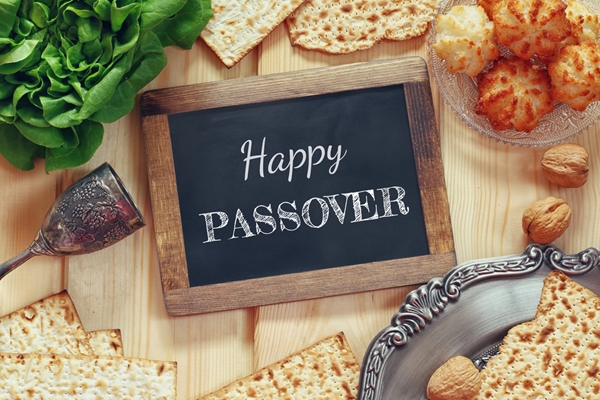Passover is just around the corner, which means it's time to start planning for the big Seder. The menu, however, isn't an easy one to create. It combines the culinary expectations of a delicious Thanksgiving meal, but an Iron Chef-like twist: cook a multicourse meal without leavening. Seems challenging, right? That's why CardsDirect is helping you plan early.
Here's a six-step guide to hosting your own Passover Seder:
1. Send an invite
First things first: What's a party without an invitation? Create a guest list and send a Passover invite to all your friends, family members, neighbors, coworkers – the more the merrier! This is the festival where it's perfectly OK to reach out to as many people as you know and send them an invitation to the Seder. There's even a verse in the Haggadah (liturgy describing the details of the story of Exodus from Egypt) that says, "Let all all who are hungry come in and eat."
Include important details like the who, what, where, when and why. If you're hosting a potluck-style Seder, be sure to include that in the invitation. Expect some phone calls or emails asking what type of dish to bring. If you're inviting friends who don't typically celebrate this holiday, they probably don't know much about it. Draft up a paper insert with details about what Passover is all about! Explain why unleavened bread is eaten and why this holiday lasts eight days.
2. DIY Haggadot
As stated above, the Haggadot (plural) is a Jewish text that is only read on Passover. It guides the ritual meal and commemorates the Jewish liberation from slavery in Egypt. On the first two nights of the holiday, loved ones are gathered around the Seder table to enjoy the 15-step meal and recitation of the Haggadah. In English, the word Haggadah means "to tell."
There are many forms of the Haggadah to suit both cultural and spiritual preferences, as there are always two sides to every story. Do some online research to find a text that you prefer. This could be a text ranging anywhere from Buddhist, gender-inclusive, hip-hop, theatrical or an environmentally sustainable approach. Print as many copies as you have guests, bind and distribute them. Since you're making your own Haggadot, allow your guests to take theirs home after the Seder. Consider including thank you cards at the end, too!
3. DIY Seder plate
If you normally go to grandma's for Passover, you've never had to worry about having your own Seder plate. You're definitely going to need one, seeing as this may be the most important element of the dinner – it's also the centerpiece. The Seder plate holds five important foods, each with their own cultural significance that you will touch on as you read through the Haggadah. Instead of going out and purchasing a fancy plate, turn to the DIY method and make your own. Get creative with empty tuna cans or cupcake liners and place all elements of the Seder plate in those items.
4. Potluck meal
Since you're going to be busy making the Seder plate, printing and binding your own Haggadot, and setting up your home, you may not have time to cook a multicourse meal for all your guests. Reach out and ask for help! Potluck dinners are always welcoming, and it's a great way for guests to become culturally invested in your holiday. Since there are certain dietary restrictions to this holiday, be sure to give your guests a list of ideas for what they can bring. Don't forget about dessert!
5. Passover picnic
Depending on how many guests RSVP "Yes," you may run out of room in a narrow apartment. Not to worry! One of the main ideas of Passover is that on this night, you recline when you eat. As a ritual, some people will even place a pillow on their chair and sit on top of that. While Passover is an extremely religious holiday, it's one of the more relaxed ones. Throw some pillows on the ground – maybe even some bean bags. Forgo the tables and lay out blankets instead. Have everyone gather around in a circle and you've got yourself the perfect Passover picnic.
6. Find the afikoman
This is another Passover ritual – a game mostly for the kids. The afikoman ("that which comes after" or "dessert") is a piece of matzo (unleavened bread) that is broken in half during the Seder and is set aside in a protective covering to be eaten after the meal. Instead of eating it, it has become a well-known tradition for the host to hide the afikoman somewhere around the house for the kids to find, and reward the one who found it with a monetary prize. In keeping with the tradition, hide the afikoman somewhere around your home and have all your guests spread out and look for it.
Don't forget to light the Shabbat candles, drink a lot of Manischewitz wine and, of course, have a blast. Happy Passover from CardsDirect!

